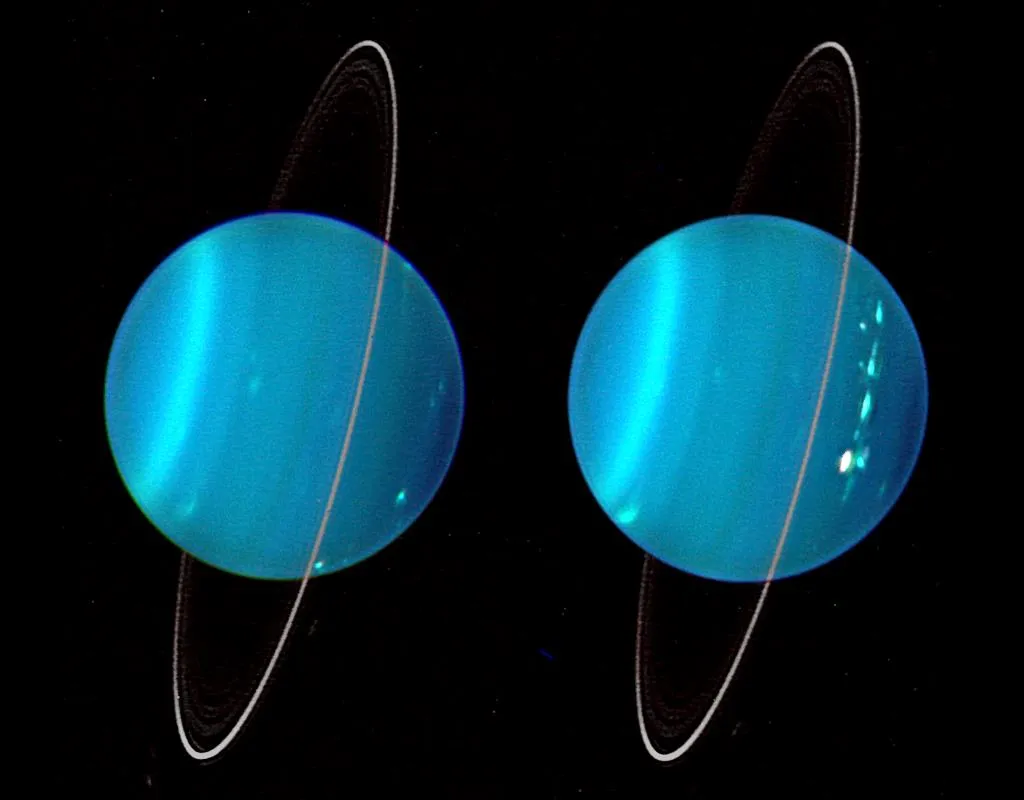Uranus isn’t much to look at. When Voyager 2 flew past the planet in 1986, it found a uniform ball that is tinted sky blue by methane in the atmosphere. But looking beyond the calm exterior reveals a planet where winds blow at speeds in excess of 900km/h, in the wrong direction.
While most planets’ spin axes are at right angles to their orbits, Uranus has been knocked over onto its side.
No one is entirely certain why, but the lead theory is that an Earth-sized planetoid collided with Uranus early in the Solar System’s history, tipping it over.

However, Uranus isn’t always as calm as when Voyager 2 spied on it.
As the planet takes 85 years to orbit the Sun, the seasons last for decades and the probe passed by during the planet’s northern summer.
When Uranus passed into autumn in 2007, long-range observations found the planet seemed to wake up, with storms creating bright spots the size of North America in the planet’s atmosphere.
Facts about Uranus
- Diameter: 50,724km (3.98 times Earth)
- Mass: 86.8 trillion trillion kg (14.5 times Earth)
- Distance from the Sun: 2872 million km (19.2 AU)
- Length of day: 17.2 hours
- Length of year: 83.8 years
- Number of moons: 27
- Average temperature: -195ºC
- No of spacecraft visitors: 1
- Type of planet: Ice giant
How to observe Uranus

With a dark sky and good eyesight, it should just be possible to make out Uranus with the naked eye when it is at opposition (when it's positioned in the opposite part of the sky to the Sun). For more on this, read our guide How to see Uranus.
For the best views, however, you should use a telescope.Uranus should begin to become clear with an aperture of at least 3 to 4 inches and a magnification of 100x to 150x.
At these high magnifications, your observations may be affected by a phenomenon known as seeing, where the turbulence in Earth's atmosphere causes the image to shimmer.
Experiment with different eyepieces, a Barlow lens and focal extenders to find the best magnification on any given night.It is possible to take a photograph of the planet's disc, but its distance from Earth makes doing so something of a challenge.
How was Uranus discovered?
While Uranus is just about visible with the naked eye, it is so dim and moves so slowly that ancient astronomers overlooked it.
After the invention of the telescope, several astronomers did spot the planet, but it was only when William Herschel observed it in 1781 that its true origin became apparent.
He first reported his sightings as a potential comet, and later recognised it as a planet.
Why is it called Uranus?

The planet was initially named George, in honour of the English king at the time who’d given Herschel a grant in recognition of hid discovery.The name was understandably unpopular outside of Britain.
In 1782, German astronomer Johann Bode suggested Uranus after the roman god of the sky and father of the Titans, which would blend in better with the other planets.
Uranus's moons, meanwhile, were named by William Herschel’s son, John, who decided to name them after characters from English literature (most from Shakespeare).
The trend has continued as more moons are discovered.
How should you pronounce Uranus? The planet's name has become something of a joke in recent years, leading some to wonder how to say the planet's name without causing giggles or smirks. Generally speaking, astronomers pronounce Uranus as YOOR-aniss, with the stress on the first syllable.
What missions have explored Uranus?

So far only one mission has visited Uranus, Voyager 2, which flew past the planet in 1986. The mission showed Uranus was an almost featureless green-blue ball.
In the years since, telescopes on Earth and in orbit have improved to the point where they can now take detailed images of the planet, allowing us to make out the changing weather on its surface.
It seems that the planet’s upper atmosphere has become much more varied since then, suggesting that we happened to fly past the planet during a particularly calm point in Uranus’s climate cycle.
Uranus missions
- Voyager 2 (1986, NASA)
Below is a selection of images captured by astrophotographers and BBC Sky at Night Magazine readers. For more info on astro imaging, read our guide on how to photograph planets or our beginner's guide to astrophotography.
And don't forget to send us your images or share them with us via Facebook, Twitter and Instagram.






